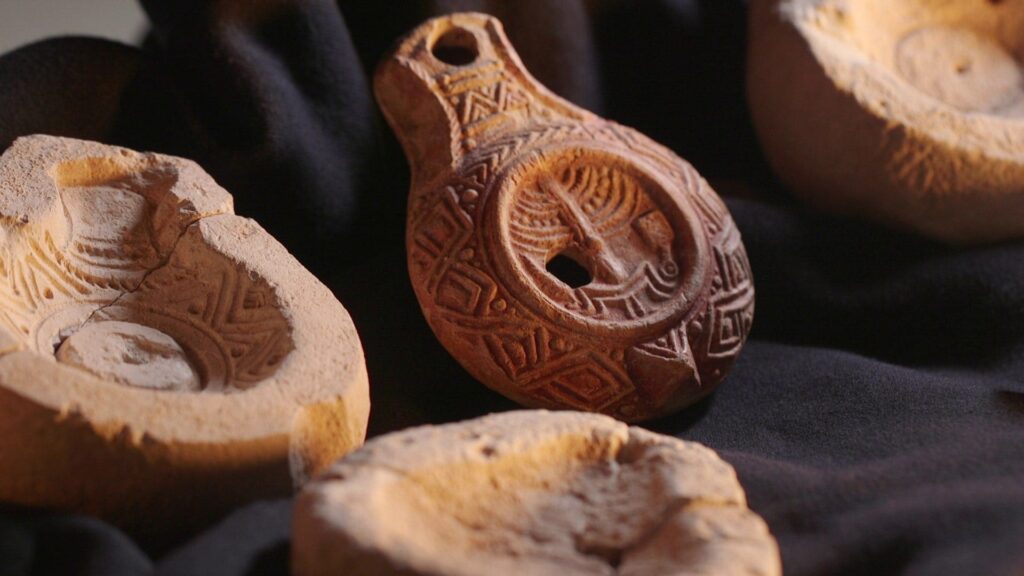Israeli archaeologists have recently uncovered a remarkable oil lamp dating back to the fourth century, coinciding marvelously with the festive spirit of Hanukkah. The Israel Antiquities Authority (IAA) shared this intriguing discovery through a Facebook post on Thursday, detailing the find that occurred during an excavation near the historical Mount of Olives in Jerusalem. This area, rich in religious and cultural significance, has often been a focus of archaeological interest and is known for yielding artifacts linked to ancient societies.
The oil lamp is believed to date from the Late Roman Empire period, a time marked by significant socio-cultural shifts. What makes this lamp particularly noteworthy is its artistic details that reference the Second Temple, a critical landmark in Jewish history, despite the fact that it was created over two centuries after the temple’s destruction in 70 A.D. Archaeologists uncovered intricate carvings on the lamp depicting an incense shovel, a menorah, and a lulav — a frond of the date palm that holds significance during the Jewish festival of Sukkot. These symbols highlight the connection between the Jewish identity and their ancient religious practices, underscoring the lamp’s cultural importance.
Michael Chernin, the IAA Excavation Director, emphasized the exceptional craftsmanship of this artifact during his remarks. He stated, “The exquisite artistic workmanship of the lamp, which was found complete, makes it outstanding and extremely rare.” Chernin noted that the absence of similar artifacts from this era complicates historical knowledge regarding Jews in Jerusalem during the fourth century, during which time they faced considerable challenges including persecution under Roman rule.
The lamp also features visible soot marks around its nozzle, suggesting it was actively used approximately 1,700 years ago. The Israel Antiquities Authority described this unique find as providing “a fascinating glimpse into Jewish cultural and religious life during this period,” allowing historians to gather insights into the daily lives of those who inhabited Jerusalem long ago.
As the Late Roman Empire transitioned towards Christianity as its dominant religion, the Jewish population was significantly impacted. Chernin elaborated on this period, noting that following the suppression of the Bar Kokhba revolt by Emperor Hadrian in 135 CE, Jews faced expulsion from Jerusalem, which led to a decrease in their presence in the city. The Mount of Olives lamp serves as one of the scant material remnants reflecting Jewish life between the 3rd and 5th centuries CE, making its discovery particularly significant within the archaeological community.
Benjamin Storchan, a research archaeologist with the IAA, further elaborated on the lamp’s manufacturing process, noting the considerable skill involved in its design and creation. “The lamp was made using delicately and intricately carved limestone molds using drills and chisels,” he explained, revealing that the molds were constructed in two parts — an upper and a lower segment — allowing for a detailed and focused design process. The craftsmanship involved suggests the lamp was likely purchased by a Jewish individual who valued its religious symbolism and connection to the Temple.
To share this historical artifact with a wider audience, the lamp is currently on public display at the newly opened Jay and Jeanie Schottenstein National Campus for Archaeology in Jerusalem. It is accessible to visitors throughout the Festival of Lights, offering an educational opportunity for those interested in the rich tapestry of Jewish history and culture.
Andrea Margolis, a writer for Fox News Digital, highlights such discoveries, emphasizing their importance for both historical and contemporary understanding of cultural heritage. Readers are encouraged to engage with the ongoing narrative of history as it unfolds through significant archaeological finds like the Mount of Olives lamp.



